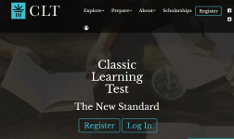The CLT (Classic Learning Test) was developed in 2015 as an alternative to the two widely-used college and university admission exams, the SAT and the ACT. The founders of CLT were concerned about the content of the two major exams as they have become more closely tied to Common Core and have exhibited increasing bias against beliefs held by conservative Christians. The CLT assesses aptitude and skills rather than a specified body of knowledge.
Despite the name—Classic Learning Test— the exam is not limited to students receiving a classical form of education. As they explain on their website, the CLT
is structured and supported by principles and values which come from the rich heritage of the Western academic and theological tradition, what Mortimer Adler called the Great Conversation. To succeed at the Classic Learning Test does not require any specific religious affiliation; the CLT is open to students of all faiths who are serious about their academic work, the pursuit of virtue, and the beauty, truth, and goodness found in our Western heritage (https://www.cltexam.com/faq).
This means, among other things, that reading passages often reflect a Judeo-Christian worldview including belief in a transcendent God. You can view a read-only sample test or take a practice test by clicking here.
The CLT is taken at your choice of designated test sites. Tests are completed online with some exceptions for special circumstances. Students need to bring their own laptop, computer, or tablet to use except in the rare exceptions where the testing sites provide computers or tablets. Prior to the test date, students should take the free practice test using the same device they plan to use for the actual test to ensure that it will work.
The CLT10 is a modified version of the CLT that should be used in place of the ACT Aspire and PSAT exams. The CLT10 might be taken in freshman or sophomore years, while the CLT should be taken in the junior and/or senior year. CLT10 can be taken at home or at a testing site. Those taking the exam at home will need to have someone other than a relative proctor the exam.
CLT has partnered with the National Association of Scholars to provide a $2,500 scholarship (usable at any CLT partner college) to any sophomore who scores in the top 1% on the CLT10. Some of the CLT partner colleges and universities offer CLT scholarships and use CLT scores to help students qualify for other merit-based scholarships. As of September 2021, more than 100 institutions offer scholarships based on CLT scores.
As with the ACT and SAT, the CLT is divided into sections with a limited time to complete each section. The test takes two hours. It is divided into three sections: Verbal Reasoning (40 minutes), Grammar/Writing (35 minutes), and Quantitative Reasoning (45 minutes). There is no optional essay.
The CLT has acquired almost 200 partner colleges (as of September 2021) including at least one state university. Partner colleges include many of those highly regarded among homeschoolers including many institutions that are Catholic, Protestant, or Orthodox. They have also created many testing sites with more being added continually. You can find partner colleges and a list of testing sites on their website.
The Classic Learning Test has created an impressive list of partner colleges in the short time it has been in existence. However, students need to check the current list of colleges accepting the CLT in lieu of the SAT or ACT since it is still a limited number. Since problems with the SAT and ACT have been getting worse, the CLT offers an increasingly compelling option for those who are pursuing different educational goals than the government schools.








